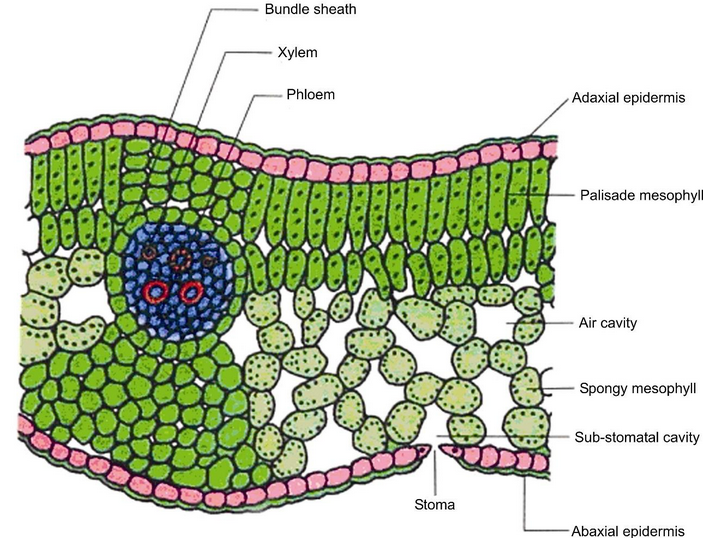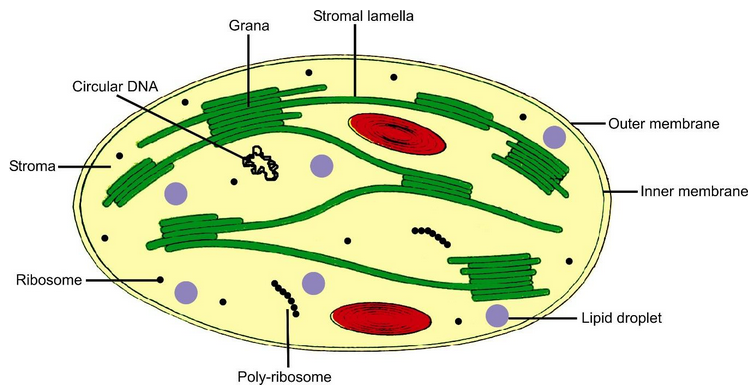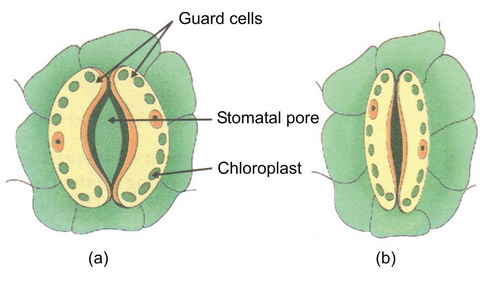
Photosynthesis
Life Process of Class 10
Photosynthesis:
Green plants are capable of manufacturing their own food in the form of carbohydrate in presence of light by using water and carbon-dioxide, this process is called photosynthesis.Such mode of nutrition is termed as autotrophic nutrition . Carbohydrates provide energy to the plant and the ones not used are stored in the form of starch. Starch is the reserve food of plants whereas reserve food in case of animals in glycogen.
Photosynthesis is the process by which green parts of the plantsynthesize organic food in the form of carbohydrates from CO2 and water in the presence of sunlight.

Mechanism of photosynthesis
- Light reaction – Thylakoids of Grana
- Dark reaction – Stroma
Events occurring during photosynthesis
- Absorption of light energy by chlorophyll .
- Conversion of light energy to chemical energy and splitting of water molecules into hydrogen and oxygen.
- Reduction of CO 2 into carbohydrate.
Steps of photosynthesis : During the process of photosynthesis, the following events occur :
- Absorption of light energy by chlorophyll.
- Conversion of light energy to chemical energy and splitting of water molecules into hydrogen and oxygen.
H 2 O → 2H + + 2e – + 1/2 O 2
The above processes are considered as light reaction as it can take place only in the presence of light.
- Reduction of carbon-dioxide to carbohydrates. This is also known as dark reaction as it does not require light.
Desert plants take up CO 2 at night and prepare an intermediate which is acted upon by the energy absorbed by the chlorophyll during the day.
Conditions necessary for photosynthesis.
- Sunlight
- Chlorophyll
- Carbon-dioxide
- Water
These conditions are needed for autotrophic mode of nutrition.
Site of Photosynthesis: Leaf in the organ where maximum photosynthesis takes place. If you see the cross section of a leaf you will find some green dots. These green dots are cell organelles called chloroplasts which contain chlorophyll. Chlorophyll containing organelles (chloroplasts) are found in large numbers in plant and algal cells.

The structure of a leaf to show chloroplasts in it.
(The small circles in the above diagram are all chloroplasts).
The chloroplasts are lens shaped, bound by a double membrane and occur in mesophyll cells of the leaf.

Internal Structure of Chloroplast
Raw materials for photosynthesis
1. Carbon dioxide: It is a gas, which is released into the atmosphere during respiration by all living organisms. This gas is utilized by autotrophic plants which enters the leaf through the stomata present on its surface during the process of photosynthesis.
2. Water: It is another requirement for photosynthesis which is transported upward through xylemtissues to the leaves, from where it reaches the photo-synthetic cells. Elements such as N, P, Fe and Mg are required by the plant to build their body is taken up from the soil along with water by roots. Nitrogenis the most important constituent of amino acid and nitrogenous bases. This is taken up in the form of inorganic nitrates or nitrites. It can also be taken as organic compounds which have been prepared by bacteria from atmospheric nitrogen.
3. Chlorophyll: It is a green pigment in plants which act as a catalyst. It is responsible for absorption of sun’s energy. The chlorophyll pigments are photoreceptor molecules which play a key role in the photosynthetic process. The different types of chlorophyll molecules are chlorophyll a, b, c, d and bacteriochlorophyll; of which chlorophylla and b are most common.
4. Light: It affects the rate of photosynthesis by its intensity, quality and duration. In green light, the rate of photosynthesis is minimum, while in red and blue lights the rate of photosynthesis is maximum. Rate of photosynthesis is higher in plants getting average light of 10-12 hrs a day.
5. Gaseous exchange during photosynthesis : Stoma are tiny pores present on the surfaces of the leaves (more on the lower surface and less on the upper surface). Stomata function in gas exchange between the plant and the atmosphere during photosynthesis. Each stoma is bordered by two bean / dumbbell shaped guard cellsin dicots andmonocots respectively. However exchange of gases also occurs across the surface of stems, roots etc.
Opening and Closing of Stomatal Pore : The opening and closing of the stomata is the function of guard cells. The guard cells swell when water flows into them causing the stomatal pore to open. Similarly the pore closes if the guard cells shrink. Since large amounts of water can also be lost through stomata the plant closes these pores when it does not need CO2 for photosynthesis.

(a) Open and (b) closed stomatal pore
EXPERIMENT TO SHOW THAT SUNLIGHTIS NECESSARY FOR PHOTOSYNTHESIS
Keep a potted plant in dark continuoulsy for 72 hours. Now, take a leaf of this plant and kept in the sun for a long time. Dip the leaves in boiling water for a few minutes to denature the enzyme. Then boil the leaves in alcohol.This process will remove chlorophyll and leaves will turn colourless.
Again, put the leaves in hot water to make them soft. Pour a few drops of iodine solution on both the leaves and observe the colour. The colour of leaf kept in sunlight will turn blue, which shows the presence of starch. The leaf that was kept in dark becomes brown indicating the absence of starch in it.
Conclusion
From the above experiment, we actually get two conclusions. That sunlight is necessary for the process of photosynthesis, and leaves make starch as food by photosynthesis.
EXTERNAL FACTORS AFFECTING PHOTOSYNTHESIS
There are number of factors which affect the process of photosynthesis thereby affecting the productivity of a plants. Each factor has three principal values i.e., minimum, optimum and maximum. Optimum means the process is taking place at its highest rate. Maximum value means beyond which the process is adversely affected.
Important external factors are :
- Light
- Temperature
- Water
- Carbon dioxide
LIGHT
In photosynthesis light is converted into chemical energy in the form of food. The rate of photosynthesis is affected by quality, intensity and duration of light. The chlorophyll absorbs mostly the blue and red regions of the spectrum.The green light has inhibitory effect. The low intensities of light increase the rate of photosynthesis while the higher intensities retard the rate of photosynthesis. Plants getting average light of 10-13 hours a day exhibit higher rate of photosynthesis.emperaturE
Temperature acts as a limiting factor under field conditions particularly on cool days. The influence of temperature on photosynthesis depends on both light intensity and availability of CO2.
An increase in temperature above 30 o C results in a fall in the rate of photosynthesis. Changes in temperature do not affect the light reactions of photosynthesis but markedly influence the rate of enzyme-mediated dark reactions.
However, the effect of temperature on the rate of photosynthesis varies from plant to plant.
Water
Water deficiency may retard the rate of photosynthesis as it is one of the raw materials for the process. Under water deficient conditions stomata remain closed to reduce the transpiration thereby affecting the entry of CO 2 .
Carbon dioxide
Carbon dioxide is present in low concentration and forms about 0.032% of the atmosphere. It enters the leaves through stomata.
The rate of photosynthesis increases with an increase in CO2 concentration up to a certain limit. Higher concentration of CO2 may prove toxic to plants.
INTERNAL FACTORS AFFECTING PHOTOSYNTHESIS
CHLOROPHYLL
Photosynthesis does not occur in etiolated and chlorophylless leaves. In the variegated leaves, photosynthesis occurs only at the places which possess chlorophyll.
ANATOMY OF LEAF
The amount of CO 2 that reaches the chloroplast depends on structural features of the leaves like the size, position and behaviour of the stomata and the amount of intercellular spaces Some other characters like thickness of cuticle, epidermis, presence of epidermal hairs, amount of mesophyll tissue, etc., influence the intensity and quality of light reaching into the chloroplast.









